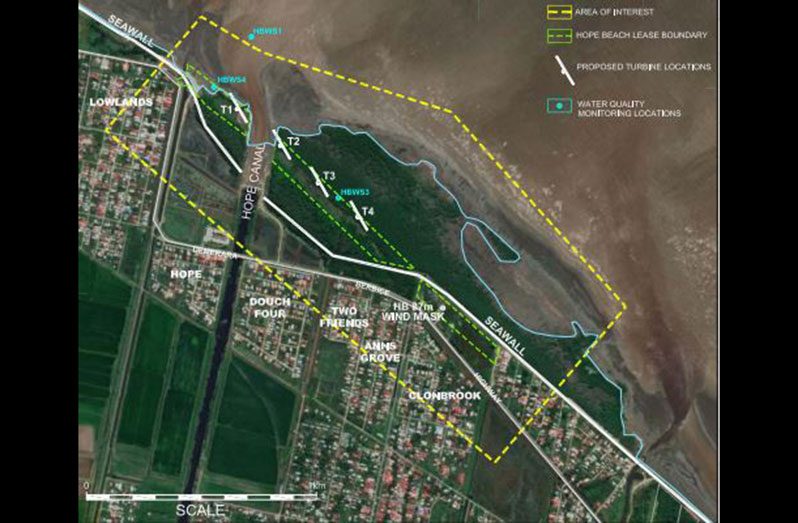–as Environmental Impact Assessment gets greenlight
–company in talks with GPL to provide power
THE massive Hope wind farm project, which could become Guyana’s first large-scale wind- energy facility, is closer to reality after the independent Environmental Assessment Board (EAB) approved the project’s Environmental Impact Assessment (EIA).
An updated EIA for the construction and operation of a wind farm at Hope Beach and Chapman’s Grove on the East Coast of Demerara (ECD) was uploaded to the Environmental Protection Agency (EPA)’s website on Friday.
On Saturday, the EPA’s Executive Director Kemraj Parsram confirmed that the project was indeed approved by the EAB “several weeks ago” and later said it was approved in the latter half of December.
The updated EIA is dated December 3, 2021. The project proposes the construction of four wind turbines along the coast at Hope Beach, ECD, outboard of the Lowland/Hope to Ann’s Grove Villages and two additional wind turbines in the Chapman’s Grove area, two kilometres (KM) farther to the south-east of Hope Beach.
According to reports, the project will cost an estimated US$35 million. And it is part of a wider plan to diversify Guyana’s energy production, thereby reducing reliance on fossil fuels such as diesel, which emit gases that are harmful to the environment.
This is in keeping with the government’s ambitious, updated Low Carbon Development Strategy (LCDS), which seeks to meet Guyana’s increasing electricity demand through the use of natural gas and renewable energy sources such as hydropower and wind and solar energy.
This proposed wind farm is expected to annually generate over 50 Gigawatt hours (GWh) of electricity, which will be delivered to the Guyana Power and Light (GPL)’s grid and will lessen Guyana’s reliance on fossil fuels for power generation.
Now that the EAB has granted its approval for the project, the EPA can start the process of granting the much-needed environmental permit. With this permit, the company can commence construction.
“Now, the EPA is making its decision whether to approve the project. We have to take the recommendations from the EAB and determine whether we will issue the permit and under what conditions,” Parsram told the Sunday Chronicle.
The EAB is an independent body that reviews projects and their potential environmental and social risks. This board was chaired by Omkar Lochan, but the life of the board expired in December 2021.
When applications for proposed projects are received by the EPA, they are screened to determine whether an EIA is required. According to the EPA, if they find that an EIA is not required, a public notice is placed in the newspaper, outlining the EPA’s decision.
TALKS WITH GPL
At the recently concluded International Energy Conference and Expo, General Manager of the Hope Energy Development (HED) Inc., John Sydow, highlighted that the company was in talks with GPL to finalise a 20-year Power Purchase Agreement
Through this agreement, a developer establishes and operates the system and a customer (in this case, GPL), purchases the electricity produced by the system. And Sydow told the conference that once this agreement is finalised, it is likely that construction will commence.
In addition to the construction of the wind turbines needed to generate the electricity, the project will involve the construction of roads and other infrastructure.
In addition to this wind farm, the project will also feature a 20-megawatt solar farm. This, Sydow explained, will be to supplement the wind energy produced, so that even when wind speed is low the project will have solar energy too.
With the combined renewable energy courses, Sydow said, “This is much, much better than we had thought that was possible when we first started this project.”












